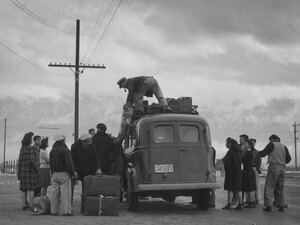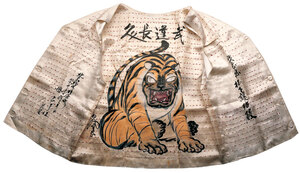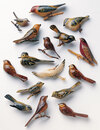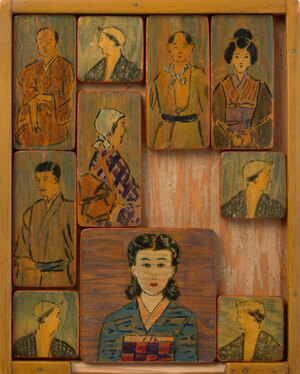
Ansel Adams/Library of Congress A 1943 Ansel Adams image shows a bus being loaded at Manzanar Relocation Center in California.
Ansel Adams/Library of Congress
A 1943 Ansel Adams image shows a bus being loaded at Manzanar Relocation Center in California. VIDEO: Watch A Challenge To Democracy, a 1944 film produced by the U.S. War Relocation Authority.
'We Had No Furniture'
Norman Mineta grew up in San Jose, Calif., the son of Japanese immigrants. He went on to serve in Congress and eventually became commerce secretary under Bill Clinton, and transportation secretary under George W. Bush.
Mineta still has vivid childhood memories of his internment at the Heart Mountain Relocation Center in Wyoming. He was 11 years old when his family was relocated to hastily built, bare barracks.
"We had no furniture," Mineta recalls. "All you get is four blank walls and one light bulb in the middle of the room and a black potbellied stove over in the corner ... and cots. That was it."
Photo: Terry Heffernan Bird and animal pins made of scrap wood, paint and metal, by Himeko Fukuhara and Kazuko Matsumoto, interned at Camp Amache, Colo., and Gila River, Ariz.
Delphine Hirasuna, a third-generation Japanese-American, was organizing family belongings after her mother's death and found a bird pin that belonged to her mother, stashed away in an old wooden box in the garage. Lacquered, with shades of brown and yellow — it was this pin that inspired the exhibit at the Renwick.
Hirasuna found many other trinkets from her family's time in internment, and began asking around for other camp-made objects. She began going house to house in California farm country.
"When I asked them if they had anything, they would go into their sheds ... and they would haul out this dusty box," Hirasuna says. "And the items in the box would still be wrapped in newspaper from 1945. So it was pretty obvious to me that they never looked at it when they brought it back from camp."

Photo: Terry Heffernan/National Japanese American Historical Society A model ship made of wood, scrap metal, wire, thread, paint screws and nails by an unidentified internee in Jerome, Ark.
Photo: Terry Heffernan/National Japanese American Historical Society
A model ship made of wood, scrap metal, wire, thread, paint screws and nails by an unidentified internee in Jerome, Ark.

Photo: Terry Heffernan/Japanese American Archival Collection Library A Senninbari vest made of silk cloth, thread, ink, buttons and paint, made by the mother of George Matsushita, while she was interned at the Amache camp in Colorado. There are 1,000 French-tied knots on the vest -- each tied by a different person in the camp.
Photo: Terry Heffernan/Japanese American Archival Collection Library
A Senninbari vest made of silk cloth, thread, ink, buttons and paint, made by the mother of George Matsushita, while she was interned at the Amache camp in Colorado. There are 1,000 French-tied knots on the vest -- each tied by a different person in the camp.
From the Amache internment camp in Colorado came a silk vest a mother made for her son who was going off to war. (Eventually, some of the internees were drafted or even volunteered for a special combat unit of U.S.-born Japanese-Americans.) The cream-colored vest is decorated with 1,000 red, French-tied knots.
"One person made each knot," explains Robyn Kennedy, chief of the Renwick. "This was passed around in the camp, and this was in order to provide strength and good luck for the person it was given to."
On the back of the vest a ferocious tiger is painted in orange and black ink. His hunched shoulders and sharp teeth show his strength.
"No one is going to go through that tiger to get this person's back," Kennedy says.
It's ironic that people of Japanese ancestry could fight and die for America, but in those post-Pearl Harbor days, they were also seen as a potential threat. They looked like the enemy. Families were told they were relocated for their own protection, but even at age 11, that made Norman Mineta wonder.
"You have guard towers every [200], 300 feet all around the camp with barbed wire, holding us in," he says. "You look up and you wonder: If we're in here for our protection, why are those machine guns pointing at us?"
Photo: Terry Heffernan/Collection of Alice Ando and Jean Matsumoto A puzzle made of wood, paint and shellac by Kametaro Matsumoto, while interned at Minidoka, Idaho.
The Art of Gaman exhibit provides striking visual evidence of how internees coped — fashioning, by hand, arts and crafts that enhanced their difficult days.
"Gaman means to bear the seemingly unbearable with patience and dignity," Hirasuna explains.
She began work on her picture and history book — also called The Art of Gaman — not long after Sept. 11, 2001. She says she is inspired by the way internees discovered their creative talent.
"It makes me wonder what we, all of us, have in ourselves," Hirasuna says. "Could we create things of beauty like that in adversity in such a situation?"
There were a few professional artists in the camps — some of the internees had been illustrators for Disney. But most of the people in the camps had not created art or crafts before their internment — and never did again. They went back to being doctors, dentists, farmers, shop owners.
To Hirasuna, their acts of creativity are also acts of courage — "the quiet courage of people who are put in the worst circumstances, and they find it in themselves to rise above it and make things that are truly beautiful."


No comments:
Post a Comment